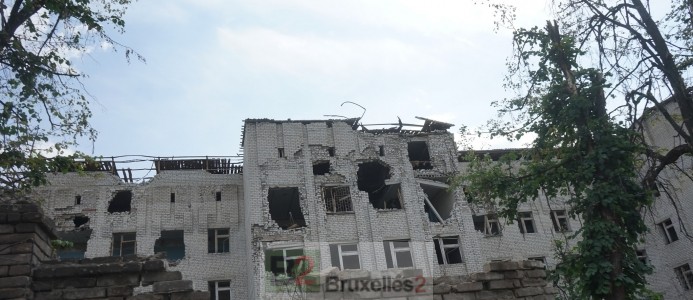NATO. Objective: to degrease the mammoth…

(At Evere, NATO headquarters) Defense Ministers have agreed to significantly reduce the size of NATO. As AF Rasmussen, its general secretary, put it bluntly, “ you have to cut the fat and keep the muscle ". Thus NATO, which has about “13.000 at its headquarters in the 11 command posts, will have 9.000 men in the long term, explained the Secretary General during his press conference. As to " 14 Agencies, there will only be 3 ". Statement approved by the French Minister of Defence, Hervé Morin, “ it is high time to convert the structures of the Alliance to the changing context, and a bureaucracy that is well worth contracting. The reduction of the structure, cis a fight I have been fighting with our British friends since 2007 - adds the minister -. It's a permanent obsession. ".
Explanations ...
The truth is a little more complex. The figure of 9.000 quoted by the Secretary General is not false. To be very exact, this figure would be 8.950 very exactly. Not very far from the objective set by the Franco-British couple who intended to reach a figure of 8.500 people (including nearly 2.000 dedicated to the 6 Awacs, according to a French source). But that number doesn't say it all...
6000 people without control
NATO has, in fact, today nearly 20.000 people. Because a certain number of agencies, more or less independent, were created, and account with the counter more than 6.000 people. That is half of the workforce cited by the secretary general. Which is far from negligible!
Agencies with very variable staff: 1150 at NAMSA, 850 at NC3A up to 35 at NAMA (which manages the C17s) or 21 at BICES... (*) And even if the secretary general proposes a grouping in 3 agencies: Acquisitions, Support, Communications, there are still agencies outside the scope. There lies the problem, explains in Brussels2 an expert on the file, as in that of control and governance.
These agencies"vote their own budget, often without too much control and their operation is quite opaque"Thus these agencies have planned to reduce their operating budget by 20%. But nothing has been planned as "target goal for the workforce. Not even not to replace the retirements". The structure "resist" he comments. And the fear is strong among the States contributing heavily to see these agencies reincorporate the posts cut on the other side. This is a main issue for future discussions. The Lisbon summit, in November, is only the beginning and these discussions should continue until June.
The degreasing in the commandments
The 11 command posts should increase to 7.
Today. To be precise, today there is the Allied Command "Operations" (SHAPE) in Mons (Belgium), the Allied Command "Transformation" (ACT) in Norfolk (USA), 3 Joint Force Commands (JFC OR JHQ) - To Brunssum (Netherlands), Naples (Italy), Lisbon (Portugal) - and 6 Joint Force Component Commands (JFCC): Air component at Ramstein (Germany) and Izmir (Turkey), Sea to Northwood (UK) and Naples (Italy), Earth component at Heidelberg (Germany) and Madrid (Spain).
Tomorrow, there will remain 7 elements: SHAPE and ACT, 2 force commands and 3 component commands (Land, Air Sea). Who will disappear?..."The boxes are currently empty, and will remain so until Lisbon"explains an expert. But no need to be a diviner to know that Germany and Italy, well endowed, are in the crosshairs. Hervé Morin refused to confirm it. But he gave two principles: “It is important to keep a structure in the United States because it is the transatlantic link and ensuring American involvement in Europe” (i.e. Norfolk) "as well as a command in Türkiye because it has a major political and geostrategic significance (i.e. Izmir). Opinion shared by Robert Gates, US Secretary of Defense
The challenge of budget control ...
As for NATO's overall operating budget, it reaches the modest sum of 2 billion US dollars. A budget that has been increasing rapidly since 2002. We can therefore understand the concern of the largest contributor States, such as France (1) and the United Kingdom, joined by the United States. Between them, the three countries provide, in fact, more than half of the NATO budget (and with Germany, we reach more than 2/3!). A concern reinforced by the budgetary crisis. Coupled with a little bitterness on the French side to see certain countries obtain a return on investment from which companies in France do not benefit. NAMSA's deals assures one diplomat, " will often for a good part of the 2 million euros of market to American or Canadian firms which use companies under Belgian name, in cover".
The issue of structural reform therefore also covers what is modestly called "financial governance", namely obtaining a certain rigor and budgetary control, particularly over the agencies. " With our efforts, we managed not to spend the reserve envelope of additional 165 million euros, decided at the Istanbul summit ” we assure on the French side.
It is true that NATO has a problem with budget transparency. Thus to obtain the exact budget of the organization, one has the impression of asking for the keys of the nuclear heads. The organisation's website, although well supplied, does not contain any up-to-date information. As for NATO from A to Z, B does not contain the budget box...
(1) France contributes around 130 million euros to the budget (13,75% of the civil budget and 12,87% of the military budget.
(*) Some NATO agencies
- La NAMSA (NATO Maintenance & Supply Agency) provides support for Alliance operations, in particular managing supply contracts and services in theaters. A significant budget of 2 billion euros per year. Based in Capellen (Luxembourg).
- La NAPMA (NAEW&C Program Management Agency) which manages the Awacs monitoring program.
- La NC3A (NATO Consultation Command and Control Agency) manages the CIS (Communication and information systems).
- La NCSA (NATO CIS Service Agency) deals with the deployment and support of CIS systems. Based at Shape in Mons (Belgium).
- la NACMA (NATO Air Command and Control System Management Agency) is the management agency of the Air Command and Control System. Based in Brussels.
- la CEPMA (Central Europe Pipeline Management Agency) is NATO's “gasoline service”. Based in Versailles (France).
- la RTA (Research and Technology Agency) is the Research and Technology Agency.
- la NSA (NATO Standardization Agency) is the standardization agency.
- the NURC (NATO Undersea Research Center) carries out research activities in the field of underwater warfare. Based in La Spezia (Italy).
- le NATO Defense College is the training institute of the Alliance. Based in Rome (Italy).
- The BICES (Battlefield Information Collection and Exploitation System)...



Comments closed.